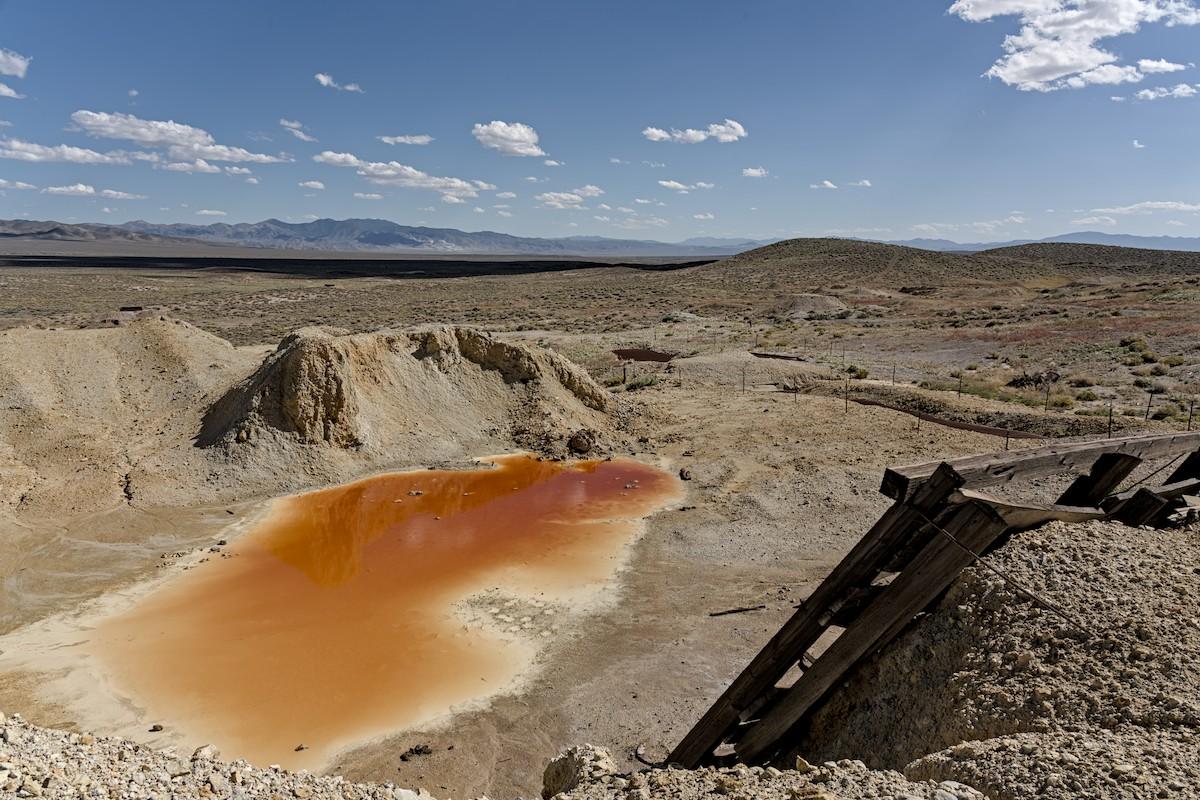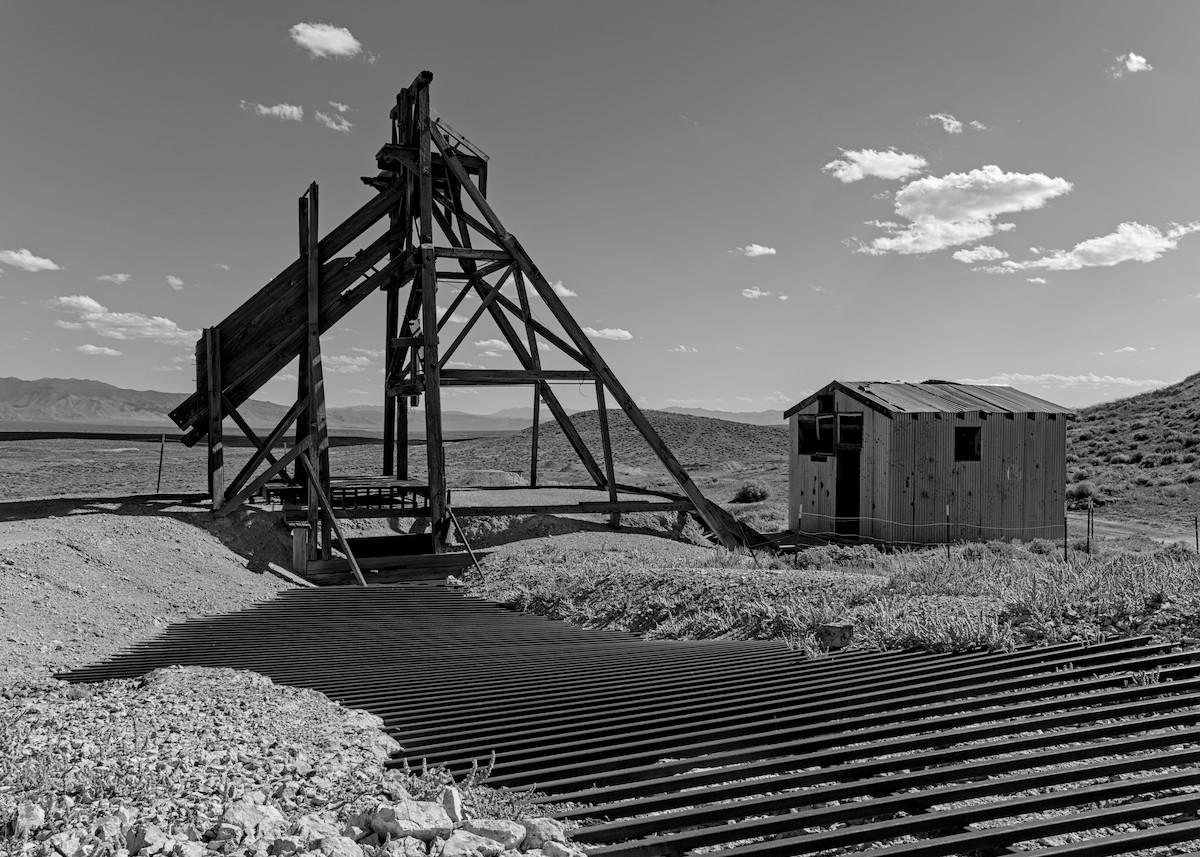Acid mine drainage (pit lake), Broken Hills, Nevada. Chemicals that leach out of mine tailings result in high concentrations of acids in puddles, ponds, and if containment fails, streams and rivers. This is a tiny--but very poisonous--puddle. I have also seen gigantic pit lakes in Nevada. The old Anaconda Copper Mine in Yerington has a very large pit lake. It is an EPA Superfund site, that like so many others, just sits there.
Head frame at Broken Hills, Nevada.
#Mining #History #BlackAndWhite #Travel #RoadTrip #Abandoned #GhostTown #Photography #Darktable
The European Union will unveil measures next week to cut the bloc's over-reliance on China for critical raw materials as Europe seeks to keep up with fierce global competition from the U.S. and Asia. https://www.japantimes.co.jp/business/2025/12/01/eu-raw-materials-china/?utm_medium=Social&utm_source=mastodon #business #eu #china #trade #rareearths #mining
Acid mine drainage (pit lake), Broken Hills, Nevada. Chemicals that leach out of mine tailings result in high concentrations of acids in puddles, ponds, and if containment fails, streams and rivers. This is a tiny--but very poisonous--puddle. I have also seen gigantic pit lakes in Nevada. The old Anaconda Copper Mine in Yerington has a very large pit lake. It is an EPA Superfund site, that like so many others, just sits there.
Head frame at Broken Hills, Nevada.
#Mining #History #BlackAndWhite #Travel #RoadTrip #Abandoned #GhostTown #Photography #Darktable
Dazzling Harlequin Poisonous #Frogs 🐸💚 of #Colombia 🇨🇴 are sensitive to noise 🎶📢 Their rainbow colours 🌈 make them #rainforest works of art! ✨🎨Critically Endangered by #mining and #palmoil #BoycottGold 🥇🩸⛔️ #BoycottPalmOil 🌴☠️⛔️ @palmoildetect https://palmoildetectives.com/2021/03/20/harlequin-poison-frog-oophaga-histrionica/?utm_source=mastodon&utm_medium=Palm+Oil+Detectives&utm_campaign=publer
📣 New Podcast! "26 November 1926: Britain miners strike ends" on @Spreaker #history #mining #workers
https://www.spreaker.com/episode/26-november-1926-britain-miners-strike-ends--68749773
Across mainland Southeast Asia, more than 2,400 mines — many of them illegal and unregulated — could be releasing deadly chemicals such as cyanide and mercury into river water, according to new research. https://www.japantimes.co.jp/news/2025/11/24/asia-pacific/toxic-mines-southeast-asia/?utm_medium=Social&utm_source=mastodon #asiapacific #southeastasia #mining #pollution #rareearths #thailand #myanmar #china
A pricing mechanism underpinning the global copper-processing industry faces a major stress test this week, with negotiations coming to a head at a time when geopolitical tensions are running high. https://www.japantimes.co.jp/business/2025/11/24/china-copper-supply-talks/?utm_medium=Social&utm_source=mastodon #business #mining #china
Dazzling Harlequin Poisonous #Frogs 🐸💚 of #Colombia 🇨🇴 are sensitive to noise 🎶📢 Their rainbow colours 🌈 make them #rainforest works of art! ✨🎨Critically Endangered by #mining and #palmoil #BoycottGold 🥇🩸⛔️ #BoycottPalmOil 🌴☠️⛔️ @palmoildetect https://palmoildetectives.com/2021/03/20/harlequin-poison-frog-oophaga-histrionica/?utm_source=mastodon&utm_medium=Palm+Oil+Detectives&utm_campaign=publer
The Silent Killers in #IndianCountry: #Copper, #Lithium, #Uranium and #Plutonium
Judge finds plutonium plants in #NewMexico and #SouthCarolina violated environmental laws
By #BrendaNorrell, #CensoredNews, Oct. 10, 2024
"The U.S. government's plan for increased plutonium production at #LosAlamos National Laboratory, in the heart of Pueblo lands in northern New Mexico, has been delayed by a federal judge.
"Continuing the U.S. legacy of poisoning Indian country with #radiation, this comes as the U.S. government is granting leases to foreign #mining companies targeting Native #sacred lands and communities.
" #CopperMining is targeting San CarlosApache's sacred #OakFlat; #Hualapai are suing the US Department of Interior to halt lithium mining at their sacred spring Ha'Kamwe'; and the U.S. government is promoting the ongoing digging into the #Paiute Massacre Site in northern Nevada for #lithium, in violation of all federal laws that protect Native religious and historic sites, the environment and endangered species.
"Uranium mining in the Grand Canyon threatens #Havasupai's aquifer, the haul route endangers everyone in the Four Corners region, and the uranium mill at White Mesa Ute in #Utah is poisoning #Utes.
"Interior Sec. #DebHaaland said in Farmington, N.M., that Los Alamos Labs would be the leader in the so-called ' #GreenEnergy transition' in the #FourCorners region.
"More than 500 radioactive #UraniumMill sites remain on the #NavajoNation that have not been cleaned up by the U.S. #EPA, which deceives the public by announcing plans and promises to clean up the #ColdWar sites.
"In the current federal lawsuit, a federal judge in South Carolina ruled that U.S. energy officials illegally neglected to study impacts to the #environment in efforts to increase plutonium production for nuclear weapons in New Mexico and South Carolina.
"'South Carolina District Court Judge Mary Geiger Lewis sided with environmental, #AntiNuclear proliferation and community groups last week who sued the National Nuclear Security Administration ( #NNSA), which oversees the nuclear weapons stockpile as part of the U.S. Department of Energy [ #DOE],' reports Source New Mexico.
"The U.S. is investing billions into restarting the manufacture of #PlutoniumPits, the grapefruit-sized spheres developed for #nuclear weapons. The plutonium is produced from uranium.
"'The federal government halted its manufacturing program at the #RockyFlatsPlant in #Colorado in 1989 after an FBI raid due to safety concerns and #EnvironmentalCrimes,' Source New Mexico reports.
"The U.S. government's #AtomicBombTesting in #Nevada left a trail of cancer and death for #WesternShoshone. The documentary 'Downwind' reveals the truth.
"'This is a very serious issue and that's why I can't let it go. I can't move on. People say, 'oh, why don't you just let it go?' Because it's killing my family. It's killing my land. It's killing my people. And that will not stand. It's being done in secret. And killing Indians in secret will not stand,' said Ian Zabarte, Principal Man of the Western Bands of the #ShoshoneNation of Indians. Zabarte is featured in ' #Downwind' about radiation poisoning from U.S. #NuclearTests.
"Currently, foreign companies -- which receive the profits and find it easy to avoid clean up and responsibility for #environmental crimes and deaths from #cancer -- are receiving the mining leases from the U.S. government. The leases are granted by the U.S. Interior's Bureau of Land Management (BLM) and in the case of #UraniumMining in the #GrandCanyon, it is the USDA's Forestry Service. #Biden's attorneys have joined the lawsuit with #RioTinto to devastate #OakFlat.
"Australian and Canadian mining corporations are devastating Native lands and communities, poisoning the water and causing widespread cancer.
Rio Tinto, targeting Apaches #OakFlat, is an Australian company which destroyed 46,000 years of #Aboriginal sacred history in caves in #Australia.
"Another Australian mining company is targeting #Hualapai's sacred site. It is #Hawstone / #ArizonaLithium, in Perth, Australia.
" #EnergyFuels, now uranium mining in the Grand Canyon, and operating the uranium mill at #WhiteMesaUte, is a Canadian company. Another Canadian company is digging into the #Paiute Massacre Site. It is #LithiumAmericas.
#Hopi judge #DianeHumetewa granted a temporary restraining order to halt the lithium mining at #Hualapai's sacred spring."
Read more:
https://bsnorrell.blogspot.com/2024/10/the-silent-killers-in-indian-country.html
#NoUraniumMining #CopperMining #LithiumMining #NoMiningWithoutConsent #EnvironmentalRacism #NoWar #NoNukes #NuclearWeapons #RecycleCopper #RecycleLithium #WaterIsLife #NuclearWaste #DefendTheSacred #WhiteMesaMill #Ute #AtomicBomb #CulturalGenocide #Genocide #FirstNations #NativeAmericanNews #SuperfundSites #ToxicWaste #SaveOakFlat #OpenPitMining #Pollution #ReaderSupportedNews
Found a new favorite subreddit: https://www.reddit.com/r/OptimistsUnite/top/
Never fails to cheer me up. I've been saving some quotes, but honestly there are too many good ones. I'll post some of my favorites.
#collapse #optimism #renewables #ClimateChange #ClimateCrisis
"Mining on the moon for Helium 3 is starting soon. Energy technology is leaping, orbital solar is becoming workable, as well as geothermal, so free clean unlimited power is 1/2 a generation away. Optimus Robots don’t need air to work in space."
"There's already plans underway to replace traditional rocket fuels and systems with things like nuclear."
"We could even use asteroid mining to pay off the national debt, when the appropriate tech is available."
1/3
The start up at Simandou threatens to further tilt the power dynamics in a market already facing uncertainty as its top buyer, China, is pushing for greater influence over the world’s most-traded commodity after oil. https://www.japantimes.co.jp/business/2025/11/04/markets/china-africa-mine-iron-ore-market/?utm_medium=Social&utm_source=mastodon #business #markets #china #iron #metals #ironore #mining #africa #riotinto
#UncontactedIndigenous peoples & efforts to protect them
From the depths of Brazil’s Amazon to Indonesia’s rainforests, some of the world’s most isolated peoples are being squeezed by #roads, miners & drug traffickers—a crisis unfolding far from public view or effective state protection.
#law #InternationalLaw #IndigenousPeoples #IndigenousRights #LandConservation #LandRights #SaveRoadless #logging #mining #agribusiness #Climate #ClimateCrisis
https://apnews.com/article/uncontacted-indigenous-amazon-mining-logging-5d8d90cf8e13f44a5202101fee62b583
A new report by #SurvivalInternational, a London-based #IndigenousRights organization, attempts one of the broadest tallies yet, identifying at least 196 #UncontactedIndigenous groups in 10 countries, primarily in South American nations sharing the #AmazonRainforest. Released Sunday, the report estimates that nearly 65% face threats from #logging, ~40% from #mining & ~20% from #agribusiness.
#IndigenousPeoples #LandConservation #LandRights #SaveRoadless #ClimateCrisis
https://uncontactedpeoples.org/
“These are what I would call silent #genocides — there are no TV crews, no #journalists. But they are happening, & they’re happening now,” said Fiona Watson, Survival’s research & advocacy director, who has worked on #IndigenousRights for >3 decades.
The issue often receives little priority from governments, which critics say see uncontacted #IndigenousPeoples as politically marginal because they don’t vote & their territories are often coveted for #logging, #mining & #oil extraction.
#UncontactedIndigenous peoples & efforts to protect them
From the depths of Brazil’s Amazon to Indonesia’s rainforests, some of the world’s most isolated peoples are being squeezed by #roads, miners & drug traffickers—a crisis unfolding far from public view or effective state protection.
#law #InternationalLaw #IndigenousPeoples #IndigenousRights #LandConservation #LandRights #SaveRoadless #logging #mining #agribusiness #Climate #ClimateCrisis
https://apnews.com/article/uncontacted-indigenous-amazon-mining-logging-5d8d90cf8e13f44a5202101fee62b583
A new report by #SurvivalInternational, a London-based #IndigenousRights organization, attempts one of the broadest tallies yet, identifying at least 196 #UncontactedIndigenous groups in 10 countries, primarily in South American nations sharing the #AmazonRainforest. Released Sunday, the report estimates that nearly 65% face threats from #logging, ~40% from #mining & ~20% from #agribusiness.
#IndigenousPeoples #LandConservation #LandRights #SaveRoadless #ClimateCrisis
https://uncontactedpeoples.org/
#UncontactedIndigenous peoples & efforts to protect them
From the depths of Brazil’s Amazon to Indonesia’s rainforests, some of the world’s most isolated peoples are being squeezed by #roads, miners & drug traffickers—a crisis unfolding far from public view or effective state protection.
#law #InternationalLaw #IndigenousPeoples #IndigenousRights #LandConservation #LandRights #SaveRoadless #logging #mining #agribusiness #Climate #ClimateCrisis
https://apnews.com/article/uncontacted-indigenous-amazon-mining-logging-5d8d90cf8e13f44a5202101fee62b583
Trailblazing female mining engineer remembered as pioneering transgender woman
https://www.abc.net.au/news/2025-10-25/transgender-mining-engineer-rebecca-norton/105904044
Wow Rebecca! What bravery!
Trailblazing female mining engineer remembered as pioneering transgender woman
https://www.abc.net.au/news/2025-10-25/transgender-mining-engineer-rebecca-norton/105904044
Wow Rebecca! What bravery!
After nearly 500 years of mining, Cerro Rico, the Bolivian mountain whose silver financed the Spanish Empire, is experiencing increasingly frequent and severe cave-ins.
With silver prices at decade highs, mining activity on Cerro Rico has surged in recent years, but the collapses endanger the safety and livelihoods of communities living and working on the mountain.
Efforts to preserve the mountain have been delayed and ineffective.
by Benjamin Swift
https://news.mongabay.com/2025/10/in-the-heart-of-bolivia-the-mountain-that-financed-an-empire-risks-collapsing/




